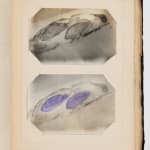[Entomology]
Student's laboratory book including microphotographs and delicate studies in colored ink of specimens under the microscope., 1907-08
Photo album; Silver prints (15) and ink drawings (21)
Overall 9 x 7 inches; 103 pages
With a lengthy manuscript introduction and detailed manuscript descriptions and notations throughout.
With a lengthy manuscript introduction and detailed manuscript descriptions and notations throughout.
Further images
-
(View a larger image of thumbnail 1
)

-
(View a larger image of thumbnail 2
)

-
(View a larger image of thumbnail 3
)

-
(View a larger image of thumbnail 4
)

-
(View a larger image of thumbnail 5
)

-
(View a larger image of thumbnail 6
)

-
(View a larger image of thumbnail 7
)

-
(View a larger image of thumbnail 8
)

-
(View a larger image of thumbnail 9
)

-
(View a larger image of thumbnail 10
)

-
(View a larger image of thumbnail 11
)

-
(View a larger image of thumbnail 12
)

This manuscript scientific treatise, completed at the University of Kansas around 1907, is titled “Embryological and Post Embryological Life of the Parasite Lysiphlebus Tritici” and contains 103 pages of text,...
This manuscript scientific treatise, completed at the University of Kansas around 1907, is titled “Embryological and Post Embryological Life of the Parasite Lysiphlebus Tritici” and contains 103 pages of text, micro-photos, and beautifully, highly-detailed drawings.
Lysiphlebus Tritici is a junior synonym for the Lysiphlebus testaceipes, which is sometimes referred to as the aphid wasp. Lysiphlebus testaceipes utilize different types of aphids as hosts. The female of the species uses an ovipositor (a tube-like organ) to lay its eggs in the greenbugs. The present manuscript carefully lays out this process, describing and documenting it in meticulous detail. The drawings, spare and surprisingly modern, are a true highlight of the book.
Lysiphlebus have been used as a biological control agent against aphid pests. This book is likely related to the work of S.J. Hunter, a professor at the University of Kansas who authored the book “The Green Bug And Its Enemies: A Study In Insect Parasitism” and championed the use of aphid wasps as control agents.
Lysiphlebus Tritici is a junior synonym for the Lysiphlebus testaceipes, which is sometimes referred to as the aphid wasp. Lysiphlebus testaceipes utilize different types of aphids as hosts. The female of the species uses an ovipositor (a tube-like organ) to lay its eggs in the greenbugs. The present manuscript carefully lays out this process, describing and documenting it in meticulous detail. The drawings, spare and surprisingly modern, are a true highlight of the book.
Lysiphlebus have been used as a biological control agent against aphid pests. This book is likely related to the work of S.J. Hunter, a professor at the University of Kansas who authored the book “The Green Bug And Its Enemies: A Study In Insect Parasitism” and championed the use of aphid wasps as control agents.
![[Entomology], Student's laboratory book including microphotographs and delicate studies in colored ink of specimens under the microscope., 1907-08](https://artlogic-res.cloudinary.com/w_1600,h_1600,c_limit,f_auto,fl_lossy,q_auto/artlogicstorage/dollc/images/view/c61d3d7323c97dd8da1ce4b47f8c54d5j/daniel-oliver-entomology-student-s-laboratory-book-including-microphotographs-and-delicate-studies-in-colored-ink-of-specimens-under-the-microscope.-1907-08.jpg)
![[Entomology], Student's laboratory book including microphotographs and delicate studies in colored ink of specimens under the microscope., 1907-08](https://artlogic-res.cloudinary.com/w_1600,h_1600,c_limit,f_auto,fl_lossy,q_auto/artlogicstorage/dollc/images/view/992d06137ce49e0924e57d809fbb1eb0j/daniel-oliver-entomology-student-s-laboratory-book-including-microphotographs-and-delicate-studies-in-colored-ink-of-specimens-under-the-microscope.-1907-08.jpg)
![[Entomology], Student's laboratory book including microphotographs and delicate studies in colored ink of specimens under the microscope., 1907-08](https://artlogic-res.cloudinary.com/w_1600,h_1600,c_limit,f_auto,fl_lossy,q_auto/artlogicstorage/dollc/images/view/b512b577b15295b21a097340ae8870a6/daniel-oliver-entomology-student-s-laboratory-book-including-microphotographs-and-delicate-studies-in-colored-ink-of-specimens-under-the-microscope.-1907-08.jpg)
![[Entomology], Student's laboratory book including microphotographs and delicate studies in colored ink of specimens under the microscope., 1907-08](https://artlogic-res.cloudinary.com/w_1600,h_1600,c_limit,f_auto,fl_lossy,q_auto/artlogicstorage/dollc/images/view/ebbf7e38fc44c6be0c9450489ab98039j/daniel-oliver-entomology-student-s-laboratory-book-including-microphotographs-and-delicate-studies-in-colored-ink-of-specimens-under-the-microscope.-1907-08.jpg)
![[Entomology], Student's laboratory book including microphotographs and delicate studies in colored ink of specimens under the microscope., 1907-08](https://artlogic-res.cloudinary.com/w_1600,h_1600,c_limit,f_auto,fl_lossy,q_auto/artlogicstorage/dollc/images/view/3c7685b4b746c687b6d0c4d7e673dfebj/daniel-oliver-entomology-student-s-laboratory-book-including-microphotographs-and-delicate-studies-in-colored-ink-of-specimens-under-the-microscope.-1907-08.jpg)
![[Entomology], Student's laboratory book including microphotographs and delicate studies in colored ink of specimens under the microscope., 1907-08](https://artlogic-res.cloudinary.com/w_1600,h_1600,c_limit,f_auto,fl_lossy,q_auto/artlogicstorage/dollc/images/view/7dd6dd4ab54328348b71004fbbd029e6j/daniel-oliver-entomology-student-s-laboratory-book-including-microphotographs-and-delicate-studies-in-colored-ink-of-specimens-under-the-microscope.-1907-08.jpg)
![[Entomology], Student's laboratory book including microphotographs and delicate studies in colored ink of specimens under the microscope., 1907-08](https://artlogic-res.cloudinary.com/w_1600,h_1600,c_limit,f_auto,fl_lossy,q_auto/artlogicstorage/dollc/images/view/319c5f47a193280a558ea66d1c1149f9j/daniel-oliver-entomology-student-s-laboratory-book-including-microphotographs-and-delicate-studies-in-colored-ink-of-specimens-under-the-microscope.-1907-08.jpg)
![[Entomology], Student's laboratory book including microphotographs and delicate studies in colored ink of specimens under the microscope., 1907-08](https://artlogic-res.cloudinary.com/w_1600,h_1600,c_limit,f_auto,fl_lossy,q_auto/artlogicstorage/dollc/images/view/cd38e0c12205c119df10e48eeaddf1a4j/daniel-oliver-entomology-student-s-laboratory-book-including-microphotographs-and-delicate-studies-in-colored-ink-of-specimens-under-the-microscope.-1907-08.jpg)
![[Entomology], Student's laboratory book including microphotographs and delicate studies in colored ink of specimens under the microscope., 1907-08](https://artlogic-res.cloudinary.com/w_1600,h_1600,c_limit,f_auto,fl_lossy,q_auto/artlogicstorage/dollc/images/view/4499ca5846c4e7d137d8c2f36142d58aj/daniel-oliver-entomology-student-s-laboratory-book-including-microphotographs-and-delicate-studies-in-colored-ink-of-specimens-under-the-microscope.-1907-08.jpg)
![[Entomology], Student's laboratory book including microphotographs and delicate studies in colored ink of specimens under the microscope., 1907-08](https://artlogic-res.cloudinary.com/w_1600,h_1600,c_limit,f_auto,fl_lossy,q_auto/artlogicstorage/dollc/images/view/047ceca19e4f2a637ed18fba9cbccdf2j/daniel-oliver-entomology-student-s-laboratory-book-including-microphotographs-and-delicate-studies-in-colored-ink-of-specimens-under-the-microscope.-1907-08.jpg)
![[Entomology], Student's laboratory book including microphotographs and delicate studies in colored ink of specimens under the microscope., 1907-08](https://artlogic-res.cloudinary.com/w_1600,h_1600,c_limit,f_auto,fl_lossy,q_auto/artlogicstorage/dollc/images/view/841cb2df886947831ede7527a14c8d82j/daniel-oliver-entomology-student-s-laboratory-book-including-microphotographs-and-delicate-studies-in-colored-ink-of-specimens-under-the-microscope.-1907-08.jpg)
![[Entomology], Student's laboratory book including microphotographs and delicate studies in colored ink of specimens under the microscope., 1907-08](https://artlogic-res.cloudinary.com/w_1600,h_1600,c_limit,f_auto,fl_lossy,q_auto/artlogicstorage/dollc/images/view/4836dd5aac461d90f0f09304b6d89989j/daniel-oliver-entomology-student-s-laboratory-book-including-microphotographs-and-delicate-studies-in-colored-ink-of-specimens-under-the-microscope.-1907-08.jpg)